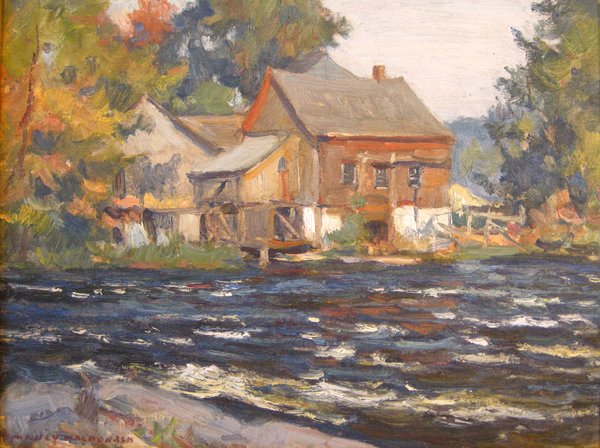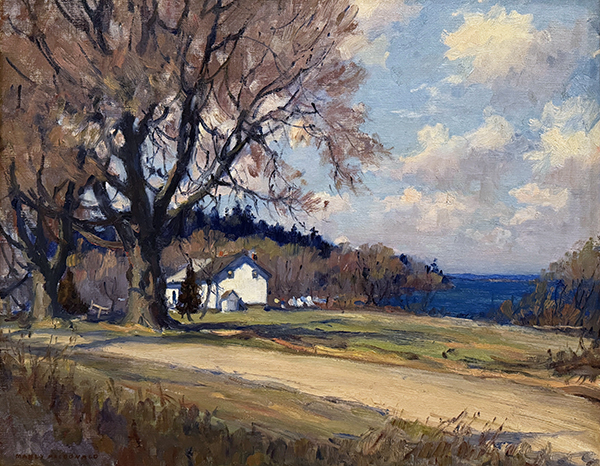Manly E. MacDonald
Manly Edward Macdonald (1889-1971) – Artist Biography
Lauded by his admirers as a skilled and sensitive “Interpreter of Old Ontario,” Manly Edward Macdonald was born in 1889 in Point Anne, Ontario, in the Belleville area. Manly showed artistic talent by the age of three and by his teenage years, he was off to the prestigious Albright School of Art in Buffalo, N.Y. and later to the Boston Museum of Fine Arts. No small expense was this for a farming and fishing family.
In 1914, Manly returned to Canada and attended the Ontario College of Art. By now he’d developed the fluid semi-Impressionistic style that would become his hallmark. Weekend au plein air ramblings took him across rural Ontario. No end of subjects there: old mills, rushing streams, tumble-down fences, and grazing cattle.
A Royal Canadian Artist scholarship in 1917 took him to the battlefields of Europe. A second fellowship followed his return to Canada when he was commissioned to commemorate women at war. MacDonald’s “Land Girls Hoeing” captured the efforts of “farmerettes” hoeing the fields in the Niagara Region of Ontario. The painting now hangs in the Canadian War Museum in Ottawa.
In 1922, Macdonald held his first public exhibition in Belleville, Ontario; in 1924 and 1925, his work was included in the first British Empire Exhibition at Wembley, and secondly at the new Canadian Pavilion. In 1938, he exhibited at the London Tate Gallery's Canadian exhibition and in 1939 at the New York World's Fair. In 1943, he began to teach at the Ontario College of Art.
Later in life, MacDonald was an active member of the Ontario Society of Artists (OSA) to which he was elected in 1918 and the Royal Canadian Academy (RCA) (he was appointed an associate member). In 1958, Manly MacDonald became a founding member of the Ontario Institute of Painters (OIP).
Although MacDonald was a reserved family man, he was embroiled in controversy over traditional versus modernist styles. This ultimately led him and three fellow OSA members (among them Kenneth Forbes and Marion Long) to resign from the OSA in 1951 on the basis that it was being dominated by modernists and not fulfilling its role of encouraging fine arts in Ontario.
1955 saw MacDonald accept a commission by the Toronto St. Clair Avenue Granite Club to paint two large winter murals. The MacDonald family bought a summer home in 1956 at the Long Reach, Bay of Quinte, south of Napanee, Ontario where he sketched and painted the pastoral landscapes of the area, as well as spoke to groups of interested people. MacDonald always had time for others, teaching incidentally to those who dropped by, or through more formal lessons. He received a commission from the St. Lawrence Seaway Authority in 1957 to commemorate the establishment of the seaway and painted seven Eastern Ontario mills. In 1958, Manly MacDonald became a founding member of the Ontario Institute of painters. (OIP). He was chosen to paint the skyline of Toronto in 1959, as a gift from the city to Queen Elizabeth II on her state visit. The commission raised the ire with more modernist artists. In 1960, Manly MacDonald mounted an exhibit at the Royal College of Art in England and for the Ontario Institute of Painters in Toronto. He returned to teach again at OCA in the 1960's before ill health forced him to stop.
MacDonald's art can be seen in major galleries across Canada, including the National Gallery of Canada and the new Canadian War Museum. Her Majesty Queen Elizabeth II owns two of his paintings in the Royal Collection Enterprises. The largest public collections are held by the John M. Parrott Art Gallery, housed in the new Belleville Public Library and at Loyalist College, also in Belleville.
Artist Specialization: A semi-impressionist and traditional painter, Manly Macdonald is not one of the school which finds most inspiration in the rugged bleakness of the north country. Charm of colour is one of his assets, combined with competent technique and ability to catch an essentially Canadian flavour. His work captured and recorded en plein air rural Ontario practices such as ploughing, cutting ice, collecting sap, logging and fishing. He is particularly renowned for his depictions of working horses in flowing motion, streams and gristmills. MacDonald was also renowned for his idealized landscapes and was a sought-after portrait artist for family and many local dignitaries.



